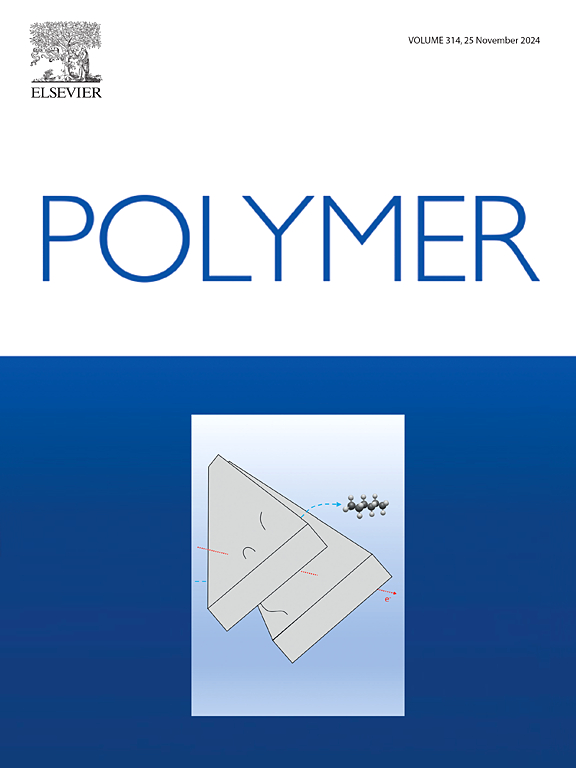In situ SAXS/WAXS studies on the evolution of hierarchical microstructure induced by hot stretching of butene-1/ethylene copolymer filaments
IF 4.1
2区 化学
Q2 POLYMER SCIENCE
引用次数: 0
Abstract
Polybutene-1 (PB-1) with form I crystals has excellent mechanical properties, creep resistance, and environmental stress crack resistance. The property of polymers is closely related to their structure, but the structure-property relationship of PB-1 filaments after hot stretching and the evolution of hierarchical microstructure is still unclear. Herein, the butene-1/ethylene copolymer with 4.3 mol% ethylene co-units (PB8220 M) filaments were used for hot stretching at different temperatures. And the effect of hot stretching on the macroscopic properties and structural evolution of the filaments were investigated by in situ small-angle X-ray scattering (SAXS)/wide-angle X-ray scattering (WAXS), combined with ex situ SAXS and differential scanning calorimetry (DSC) measurements. The results indicate that the filaments exhibit a “shish-kebab” structure for all stretching temperatures. As the hot stretching progresses, the kebab crystals (lamellae) experience partial melting, followed by recrystallization to form shish crystals under stress. And the average lengths of shish crystals at all stretching temperatures first increase and then gradually decrease with the strain due to gradual growth and subsequent fracture. Higher temperature enhances the chain mobility and accelerates the transformation of crystal structure, promoting the formation of longer shish crystals, thus improving the mechanical properties of filaments. This research can provide an important reference for optimizing the mechanical properties of PB-1 materials and expanding their application fields.


丁烯-1/乙烯共聚物长丝热拉伸诱导分层微观结构演变的原位SAXS/WAXS研究
聚丁烯-1 (PB-1)具有优异的力学性能、抗蠕变性能和抗环境应力开裂性能。聚合物的性能与其结构密切相关,但热拉伸后PB-1长丝的结构-性能关系以及分层微观结构的演变尚不清楚。本文采用含有4.3 mol%乙烯共聚物的丁烯-1/乙烯共聚物(PB8220M)长丝在不同温度下进行热拉伸。采用原位小角x射线散射(SAXS)/广角x射线散射(WAXS),结合非原位SAXS和差示扫描量热法(DSC)测量,研究热拉伸对细丝宏观性能和结构演化的影响。结果表明,在所有拉伸温度下,纤维都呈现出“羊肉串”结构。随着热拉伸的进行,烤串晶体(片)经历部分熔化,然后在应力下再结晶形成shish晶体。在各拉伸温度下,shish晶体的平均长度随着应变的增大先增大后逐渐减小。较高的温度提高了链的迁移率,加速了晶体结构的转变,促进了长晶的形成,从而提高了长丝的力学性能。该研究可为优化PB-1材料的力学性能,拓展其应用领域提供重要参考。
本文章由计算机程序翻译,如有差异,请以英文原文为准。
求助全文
约1分钟内获得全文
求助全文
来源期刊

Polymer
化学-高分子科学
CiteScore
7.90
自引率
8.70%
发文量
959
审稿时长
32 days
期刊介绍:
Polymer is an interdisciplinary journal dedicated to publishing innovative and significant advances in Polymer Physics, Chemistry and Technology. We welcome submissions on polymer hybrids, nanocomposites, characterisation and self-assembly. Polymer also publishes work on the technological application of polymers in energy and optoelectronics.
The main scope is covered but not limited to the following core areas:
Polymer Materials
Nanocomposites and hybrid nanomaterials
Polymer blends, films, fibres, networks and porous materials
Physical Characterization
Characterisation, modelling and simulation* of molecular and materials properties in bulk, solution, and thin films
Polymer Engineering
Advanced multiscale processing methods
Polymer Synthesis, Modification and Self-assembly
Including designer polymer architectures, mechanisms and kinetics, and supramolecular polymerization
Technological Applications
Polymers for energy generation and storage
Polymer membranes for separation technology
Polymers for opto- and microelectronics.
 求助内容:
求助内容: 应助结果提醒方式:
应助结果提醒方式:


